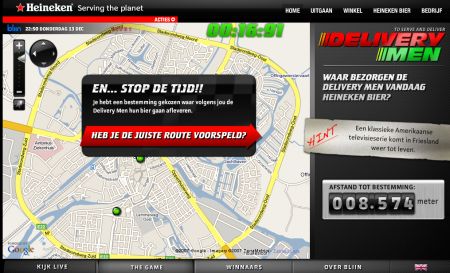von Roland Hachmann | Dez. 17, 2007 | Ad News, Blog, Digital Marketing, Marketing, Mobile Marketing, Online Advertising
Heineken in the Netherlands has launched a new advergame which looks interesting. The game asks playes to spot and track the delivery men of Heineken around the Netherlands and find out what their next stop will be. Whoever guesses correctly first, gets the chance to win a Nokia phone. So in a way, this game play is not that complicated or creative.

What I admire, is something completely different: Apparantly, these delivery men are tracked in real time with real journey data, during the regular working hours. And this is remarkable. I have also worked for clients with a huge fleet of delivery vehicles and I do appreciate the fact that Heineken managed to include their drivers into this game. Creatives usually come up easily with lots of brilliant ideas how to connect the mobile workforce of a client with a webpage via all sorts of mobile devices like phones or GPS tracking devices. But organisational reality most of the time kills these ideas.
So this won’t have been easy to push through the internal, most likely rather political, approval and commitment chain in order to get the buy in of all the different departments (marketing, distribution, logistics, etc.). Kudos, I like that.
(via)
von Roland Hachmann | Dez. 4, 2007 | Ad News, Blog, Digital Marketing, Marketing, Online Advertising
Mitch Joel blogs about advertising campaigns where the traditional campaign is long gone, but there still is a digital trail on YouTube and the likes, now leading to no longer existing microsites, etc.
In a traditional ad campaign, Marketers could get in and out in the span of a couple of weeks. Times have changed. The length of an ad campaign in the Digital Marketing space is dictated by the audience not by when the ad spend dies.
Interesting thought that has sparked a debate about purchasing the (digital) rights to media assets of integrated marketing campaigns. Here is my two cents which I put into Mitch’s comments:
Purchasing the rights to actors, directors, photography and such really depends on negotiations. I remember from my own experience that the guys at the classical advertising department were always shocked when they had to buy the rights for the internet, too. Because all of a sudden, they didn’t just buy the rights for, say, 1 year in Germany (in this case), but for world wide, because that is what the internet is: a medium that is globally accessible. It made each campaign relatively more expensive all of a sudden.
Just imagine what it will be like if they have to buy the rights not for Germany, and not for one year, but for worldwide, for ever!!
Advertisers won’t be able to not buy the digital rights. So the conclusion will have to be either: better rates in the contracts, or second rate actors, directors and photography. Not the most ideal setup.
von Roland Hachmann | Nov. 26, 2007 | Blog, Digital Marketing, Online Advertising
Doing some research regarding viral marketing, I stumbled upon the following 5 posts, here is a summary of each:
- 4 myths of viral marketing: it is a replacement for television (most videos won’t get millions of viewers), a viral video is a digital strategy (what happens after the video has been watched?), putting a video on YouTube is a digital strategy (most videos don’t really go viral without some help or trigger), bloggers are just waiting for videos they can write about (because there is so little other information around in this world).
- 7 deadly sins of advertising via viral video: Make a white and brown cow (instead of a purple, remarkable cow), pretend you’re not advertising (hoping it doesn’t backfire or gets ignored), spend a fortune on production (instead of a good idea), tell consumer instead of engage them (it’s not an adaptation of a 30 sec. spot), do a video contest because everyone else does (soon enough, it will get ever more difficult to activate consumers to the umpteenth contest), set unrealistic conversion measures (it’s not about conversion anyway, in most cases), throw in the towel and decide to just advertise around viral videos (at least to both in partnership).
- Why everyone wants viral video: 57 million Americans watch online video content every day. That’s 19% of the online population. 13% of American adults report they have downloaded or watched video ads! Two out of three viewers ages 18-29 send links to video files, compared with half of Americans age 30 and older. Forty-two percent of the 18-29 year-olds send video links a few times per month or more
- Is mass marketing important for viral success: Duncan Watts has modeled the viral phenomenon stating that it is not as contagious as we would like it to be. The circle of influence of superspreaders is far smaller than we thought, which this paper is about, and campaigns are subject to complete randomness, which makes this a channel in need of support of planned (i.e. media supported) advertising. Not true writes Nigel Hollis, saying that the stickiniess factor of the creative is not subject to randomness, as it can be pre-tested in focus groups.
- Is word of mouth a discipline or a channel: Discipline: Word of mouth marketing takes belief (based on understanding and knowledge) and discipline. Channel: The media buying companies and some advertising agencies want to see WOM as a channel. Discipline: To deliver on the promise of social media, word of mouth marketing, influencer marketing, conversation marketing – whatever part of WOM you want to emphasize – we need a simple, shared approach to measurement that compares well to what brand managers are used to. Channel: Many ad-based marketers see viral video as the answer to their WOM aspirations. And the conclusion: Word of mouth is a broad discipline like advertising or public relations. It requires technique and methodologies that are particularly relevant to do it well. It is possible to treat it like a channel by tacking on some WOM tactic to a larger advertising program, but it may not pay off in comparison to those more traditional marketing tactics.
von Roland Hachmann | Nov. 20, 2007 | Ad News, Blog, Digital Marketing, Marketing, Marketing Trends, Online Advertising, Social Media Marketing
Sofar, advertising on joost has only been in the form of short ads at the beginning or end of clips. Sort of like the traditional ad model.
Now we have the first attempt at actually providing added value through a marketing tactic. In this case, a widet:
On Thursday, Joost announced that Coca-Cola’s European division has created the first „commercial widget“ for the software. Called „Coke Bubbles,“ the downloadable advertising widget lets you choose a clip on Joost and then send it to fellow Joost users, appended with a note in the form of a „bubble.“
You can download it at „Coke Bubbles„. While I am unsure about whether this is a really clever idea, I do support the fact that Coke does not just run ads in the clips, but does try to provide added value. It’s a first step in the right direction.
A lot of marketing efforts will have to provide a clear added value in the future. Either through real product information at the points where consumers are seeking information. Or, alternatively, if consumers are not seeking product information, brands can help to provide plattforms, contents or tools for entertainment or networking – two of the other main things people seek out in digital media these days.
von Roland Hachmann | Nov. 19, 2007 | Blog, Digital Culture, Digital Marketing, Marketing
James Cherkoff tells us a nice little story about how tight marketing programs, the nice shop in a nice part of town, well trained sales people, the glossy leaflets and the good reputation of certain type of kitchen brand has been made obsolete by one single search on the web about what other customers of this brand had to say. The opinions were mostly negative and James ended up cancelling his order.
Of course, you would always have consulted other sources – most of all your closest peers – about opinions on any high involvement product or service. But the chances that you find many sources with the same brand of kitchen (car, dishwasher, etc.) in your closest range of peers was and is rather limited.
With todays possibilities to find opinions on anything on the web (even stuff you didn’t want to know about), it is ever more important for brands to keep their promises. People are fearing the moment of the totally transparent consumer, but hey, brands already face this complete transparency!


 Wo ich sonst so bin...
Wo ich sonst so bin...